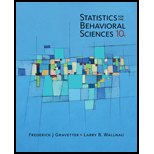
For either independent-measures or repeated-measures designs comparing two treatments, the
a. Use a repeated-measures s test with
b. Use a repeated-measures ANOVA with
| Subject | Treatment 1 | Treatment 2 | Difference |
| A | 4 | 7 | 3 |
| B | 2 | 11 | 9 |
| C | 3 | 6 | 3 |
| D | 7 | 10 | 3 |
Want to see the full answer?
Check out a sample textbook solution
Chapter 13 Solutions
Statistics for the Behavioral Sciences, Loose-leaf Version
- A researcher collects data from two dependent samples. If the dependent variable is assessed using ratio data, the appropriate difference test would be a(n): A. chi-square goodness-of-fit test. B. paired-samples t test. C. repeated-measures ANOVA. D. ANOVA.arrow_forwardThe following scores are from an independent-measures study comparing two treatment conditions. a. use an independent-measures t test with alpha level = 0.05 to determine whether there is a significant mean difference between the two treatments. b. use an ANOVA with alpha level = 0.05 to determine whether there is s significant mean difference between the two treatments. You should find that F=t2. Treatment I Treatment II 10 7 8 4 7 9 9 3 13 7 7 6 6 10 12 2 N=16 G=120 ∑X2=1036arrow_forwardDr. Spring is a consultant for the National Youth Organization of long jumpers. His goal is to predict how farany given individual will jump (4 attempts) based only on his/her height. Fortunately he had access to height and length of jumps from last year’s competition. Initial analyses of the data were as follows: contestant height (inches) (X) Length of jumps (inches) (Y) mean: 53.100 mean: 123.650 SD: 4.667 SD: 10.535 correlation coefficient= .485, p= .030 (a) Conduct a linear regressionanalysis to predict the length of jumps for the following contestants. (do not round) Contestant number one 52inches tall, length of jumps = Contestant number two 70inches tall, length of jumps = Contestant number three 77inches tall, length of jumps =arrow_forward
- The following results are from an independent-measures, two-factor study with n = 10 participants in each treatment condition. Factor A: Factor B: A₁ A₂ B₁ n = 10 M = 4 T = 40 SS = 50 n = 10 M = 5 T = 50 SS = 60 ΣΧ2 = 640 Factor B: B₂ n = 10 M = 1 T = 10 SS = 30 n = 10 M = 2 T = 20 SS = 40arrow_forwardPeter analyzed a set of data with explanatory and response variables x and y . He concluded the mean and standard deviation for x as 7.8 and 3.70, respectively . He also concluded the mean and standard deviation for y as 12.2 and 4.15, respectively . The correlation was found to be 0.964arrow_forwardThe Mean, Mode and Q.D. of a distribution are 42, 36 and 15 respectively. If its Bowley's coefficient of skewness is 1/3, find the values of two quartiles. Also, state the empirical relationship between mean, mode and median.arrow_forward
- The following data were obtained from a repeated-measures study comparing three treatment conditions. Use a repeated-measures ANOVA with alpha = .05 to determine whether there are significant mean differences among the three treatments.arrow_forwardThe time married men with children spend on child care averages hours per week. You belong to a professional group on family practices that would like to do its own study to determine if the time married men in your area spend on child care per week differs from the reported mean of 6.8 hours per week. A sample of 40 married couples will be used with the data collected showing the hours per week the husband spends on child care. The sample data are contained in the table below. 10.5 4.3 5.2 3.1 4.5 5.5 7.2 11.3 8.8 9.2 2.3 10.9 3.9 9.2 4.1 4.7 9.9 9.5 11.8 5.2 8.1 11.1 8.4 4.3 0.9 10.3 2.5 8.0 9.3 1.9 5.0 10.1 5.2 10.9 5.4 4.4 11.4 10.8 10.7 9.8 a. What are the hypotheses if your group would like to determine if the population mean number of hours married men are spending in child care differs from the mean reported in your area? - Select your answer -<>≤≥=≠Item 1 - Select your answer -<>≤≥=≠Item 2 b. What is the sample mean (to…arrow_forwardThe DASS-21 questionnaire is a validated measure of depression, anxiety, and stress. For the general population, the mean for anxiety is µ = 4.2. Anxiety levels are calculated based on self-reported answers to questions on a scale from 0 through 42, with lower scores indicating lower anxiety. Participants with gastrointestinal issues (specifically inflammatory bowel disease, IBD) completed the DASS-21. Use the data presented below to determine whether having gastrointestinal issues like IBD significantly increases risk for anxiety. Test whether or not the performance of this sample is significantly higher than the normal population using the proper t-test. Here are the data: Anxiety scores: 12, 15, 10, 8, 10, 5, 10, 13, 4, 6 ANALYSES AND UNGRADED OPTIONAL GUIDING QUESTIONS: 1a. Identify the Indep.Variable:__ Dep.Variable:__ Is it the Hypothesis one-tailed or two-tailed?__ Proper t-test statistic:__ Why? _ State Hypotheses mathematically: H0:__ H1:__ State…arrow_forward
 Glencoe Algebra 1, Student Edition, 9780079039897...AlgebraISBN:9780079039897Author:CarterPublisher:McGraw Hill
Glencoe Algebra 1, Student Edition, 9780079039897...AlgebraISBN:9780079039897Author:CarterPublisher:McGraw Hill Big Ideas Math A Bridge To Success Algebra 1: Stu...AlgebraISBN:9781680331141Author:HOUGHTON MIFFLIN HARCOURTPublisher:Houghton Mifflin Harcourt
Big Ideas Math A Bridge To Success Algebra 1: Stu...AlgebraISBN:9781680331141Author:HOUGHTON MIFFLIN HARCOURTPublisher:Houghton Mifflin Harcourt

